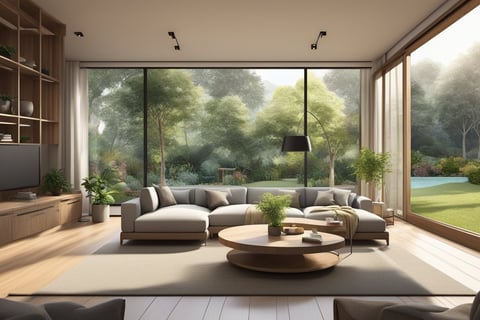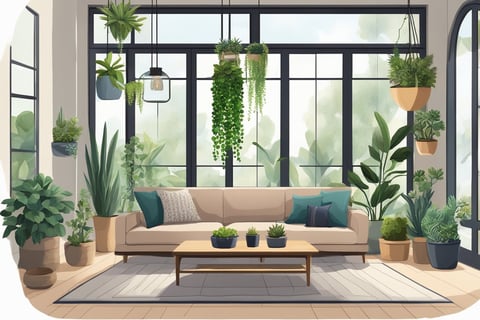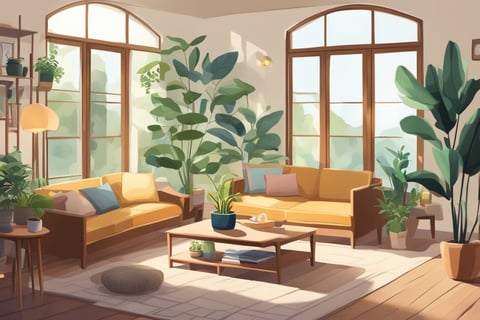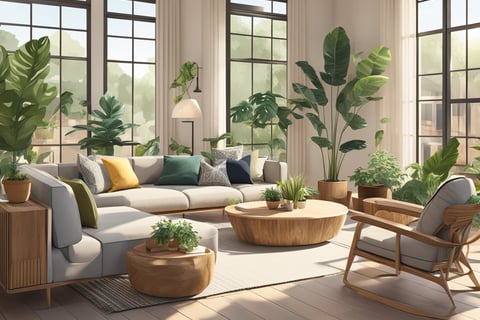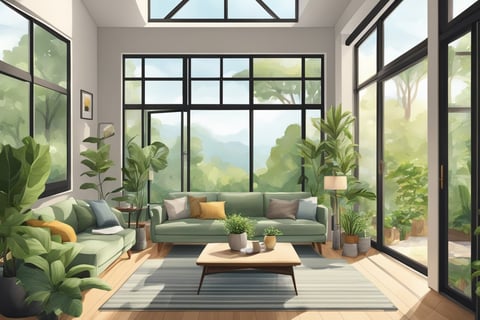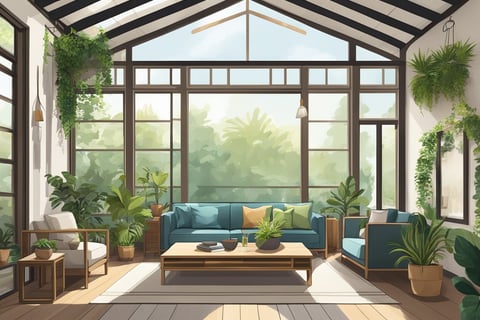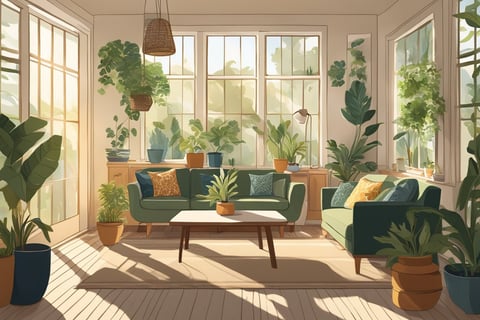Bringing the Outdoors In: Top Home and Garden Decor Trends with Natural Elements
Explore the latest in home decor with nature-inspired trends that bring the outdoors inside! From indoor plants and natural wood accents to earthy color palettes and organic textures, discover how to create a serene, eco-friendly living space that feels connected to nature. This guide covers the top decor tips and tricks for blending natural elements into every room, helping you achieve a balanced and refreshing home environment.
11/9/202410 min read
Top Trends in Home and Garden Decor: Integrating Natural Elements Indoors
Creating a seamless transition between indoor and outdoor spaces can significantly enhance a home's atmosphere. A popular trend involves incorporating natural elements like plants, wooden furniture, and expansive windows that maximize natural lighting. This approach not only brings freshness into the home but also creates a calming and inviting space.
In the realm of home and garden decor, natural elements serve as the bridge between indoor comfort and outdoor beauty. The use of wooden furniture adds warmth and texture, while strategically placed plants provide life and vibrancy. Natural lighting amplifies these effects, making spaces feel more open and connected to the outside world.
Modern interior design increasingly focuses on sustainability and simplicity. Materials such as reclaimed wood and eco-friendly plants are commonly used to reduce environmental impact while maintaining aesthetic appeal. These choices help craft homes that are as visually appealing as they are environmentally responsible.
The Importance of Blending Indoor and Outdoor Spaces
Integrating indoor and outdoor spaces enhances living areas by increasing natural elements and creating a connection with nature. This approach comes with psychological benefits and adds aesthetic value by using natural colors, textures, and lighting.
Psychological Benefits of Natural Elements
Natural elements, like plants and wood, have a calming effect on the mind. Exposure to greenery reduces stress levels and promotes relaxation. Plants also improve air quality by filtering pollutants, leading to a healthier indoor environment.
Biophilic design, which incorporates nature into interiors, can increase focus and creativity. It helps mimic the sense of tranquility found outdoors. Research shows that spending time in nature enhances mood and boosts overall well-being, making outdoor-inspired interiors a beneficial choice.
Aesthetic Value of Outdoor-Inspired Decor
Using outdoor elements like wooden furniture and natural fabrics inside adds texture and warmth to spaces. Soft, earthy tones and organic shapes create a seamless transition between indoor and outdoor areas.
Natural lighting is essential in this design, enhancing spaces with brightness and reducing energy consumption. Large windows and glass doors bring in sunlight, emphasizing open layouts and fostering a sense of spaciousness. This design approach not only beautifies homes but also emphasizes longevity and sustainability.
Incorporating Plants into Home Design
Incorporating plants can enhance home aesthetics and create a calming, fresh atmosphere. To achieve a harmonious look, it's crucial to select the right plants, ensure proper maintenance, and explore creative display options.
Choosing the Right Plants for Your Space
Selecting plants that match your space's conditions is essential for success. Consider light availability as many indoor plants require bright, indirect light. For low-light areas, opt for species like snake plants or pothos. Another factor is space size; larger plants like fiddle leaf figs can fill spacious rooms, while succulents are great for tighter spots. Don't forget to check maintenance levels; some plants like peace lilies are low-maintenance, perfect for those with a busy lifestyle.
Maintaining Indoor Greenery
Proper care ensures thriving indoor plants. Watering schedules depend on plant species and environment. A good rule of thumb is to water when the top inch of soil feels dry. Humidity plays a role, too. Tropical plants may need extra humidity, achieved by misting or using a humidifier. Regularly check for pests like spider mites or aphids. Early detection helps prevent infestations.
Creative Plant Display Ideas
Showcasing plants creatively can add to decor. Use hanging planters to introduce greenery without using floor space. Plant stands can elevate plants, creating layered heights for visual interest. Consider grouping plants of varying sizes for a mini indoor garden effect. For small spaces, wall-mounted planterscan transform a wall into a green focal point, offering a refreshing view.
Utilizing Wood for Natural Appeal
Incorporating wood into home decor enhances the connection between indoor and outdoor environments. By carefully selecting wood types, finishes, and furniture, and incorporating wooden accents, a natural and cohesive aesthetic can be achieved.
Selecting Wood Types and Finishes
Choosing the right wood can significantly impact the ambiance of a space. Hardwoods like oak, maple, and walnut offer durability and a rich look. These are ideal for long-lasting pieces. In contrast, softwoods, such as pine and cedar, bring warmth and are easier to work with for decorative elements.
Finishes also play a critical role. Natural, light finishes highlight the grain and texture of the wood, whereas darker stains provide a more sophisticated feel. Consider matte finishes for a relaxed vibe or gloss for a polished appearance. Each choice should align with the overall decor style.
Mixing different types of wood can add depth and contrast to a room. It is essential to stick to a consistent undertone, warm or cool, to ensure harmony.
Furniture Selection and Placement
Wooden furniture forms the backbone of a nature-inspired decor scheme. Choosing key pieces like a wooden dining table or media console helps anchor the room’s theme. Smarter furniture choices strike a balance between style and function.
Positioning is equally crucial. Place larger wooden pieces along focal points, such as a fireplace or a feature wall, to draw the eye. Meanwhile, opt for more subtle wooden chairs or stools in functional areas, ensuring fluidity and accessibility.
Layering different heights—with tall shelves or low tables—adds vertical dynamism. This approach maximizes both aesthetics and space utilization.
Wooden Accents and Features
Enhancing a space with wooden accents offers a gentle way to introduce natural elements. Consider items like wall panels, frames, or even wooden candle holders. These features provide a soft transition from the larger wooden furniture and inject warmth and texture into any room.
Wooden beams or ceiling panels can add architectural interest and support the overarching theme. These elements offer structural and aesthetic enhancement without overwhelming the space.
Incorporating smaller wooden elements, like wooden trays or bookends, personalizes and completes the decor, giving it a thoughtful, cohesive appearance.
Maximizing Natural Lighting
Integrating natural light into home interiors can transform spaces, enhance mood, and reduce energy costs. Key strategies include optimizing window placement, using mirrors effectively, and utilizing transparent and reflective materials.
Window Design and Placement Strategies
Achieving optimal natural lighting begins with strategic window design and placement. Large, floor-to-ceiling windows allow maximum sunlight to enter, brightening and enlarging spaces. Windows facing south can capture the most daylight, while carefully placed east-west windows offer morning and afternoon light.
Casement or awning windows are practical choices, providing maximum ventilation while letting in light. Skylights also serve as excellent sources of overhead light when wall windows are limited. Windows with low-emissivity coatings can help control heat gain without sacrificing brightness. Consider all options to maximize the benefits of natural light.
Mirror Placement to Enhance Light
Mirrors play a crucial role in enhancing natural lighting by reflecting light deeper into rooms. Strategically placing mirrors opposite windows can double the impact of incoming sunlight. Large mirrors on adjacent walls help disperse light further, reaching dim corners effectively.
Mirrors with simple, unobtrusive frames enhance their utility without becoming overpowering design elements. Full-length mirrors in hallways or entryways can also amplify light flow between spaces. Using mirrors as functional decor can significantly alter lighting dynamics within a home.
The Role of Transparent and Reflective Surfaces
Transparent and reflective surfaces further advance the benefits of natural light. Glass tables and acrylic chairs keep spaces open, allowing light to flow freely. Polished metal or glossy ceramic fixtures can reflect light, creating a brighter environment.
Utilizing light-colored walls and ceilings helps reflect more light, reducing dependence on artificial sources. Transparent materials, like frosted glass doors and dividers, transmit light while maintaining privacy. These choices ensure a balance between function and aesthetics while maximizing light efficiency.
Innovative Outdoor-Indoor Space Integration
Merging outdoor and indoor spaces involves using elements like patios that smoothly transition into sunrooms, integrating water features indoors, and utilizing outdoor fabrics and materials for durability and aesthetic appeal.
Transition Areas: Patios and Sunrooms
Patios and sunrooms serve as bridge zones that connect homes with nature. By using large glass doors or windows, these spaces allow for an unobstructed flow of natural light. Patios can be adorned with outdoor furniture to create a stylish lounge area that feels both part of the home and nature.
Sunrooms offer a year-round connection with the outdoors. These spaces can be furnished with cane or rattan pieces, providing a comfortable setting to enjoy nature without facing the elements. Including greenery in these rooms enhances the outdoor feel.
Consider using retractable screens or sliding glass wall systems to seamlessly blend the patio with the interior. This keeps the area flexible for different weather conditions, delivering both functionality and openness.
Indoor Water Features
Water features add a serene touch to interiors, creating a tranquil ambiance. Options like fountains and indoor ponds introduce the calming presence of water to living spaces. These features can be integrated into living rooms or entryways to make striking focal points.
The gentle sound of flowing water contributes to a peaceful indoor environment. It can also enhance air quality by adding moisture, particularly helpful in dry climates or during winter months.
Maintenance should be easy, choosing designs that minimize upkeep. Look for features with self-contained systems that circulate water efficiently with minimal noise and power usage, ensuring that their operation remains unobtrusive.
Incorporating Outdoor Fabrics and Materials
Bringing outdoor elements inside involves using durable fabrics like canvas, acrylic, and outdoor-grade upholstery. These materials are designed to withstand the elements, providing resilience and colorfastness even when exposed to indoor sunlight.
Wooden furniture crafted from weather-resistant woods such as teak or eucalyptus delivers warmth and natural beauty indoors. Stone materials like slate or granite can be used for flooring or countertops, introducing an earthy texture.
Implementing outdoor rugs effectively anchors furniture arrangements in open-plan areas. By using these materials, homeowners can achieve a lasting, cohesive aesthetic that honors the spirit of the outdoors within indoor spaces.
Color Palettes Reflecting the Natural World
Integrating nature into home decor begins with choosing colors that mirror natural elements. This includes earth tones, shades inspired by flora, and hues that complement a variety of textures like wood and foliage.
Selecting Nature-Inspired Colors
Nature-inspired colors bring a serene and inviting atmosphere indoors. Earthy tones like tan, olive, and sienna create warmth, while blue and teal evoke the sky and sea. Cream and off-white tones can mimic sunlight, providing a neutral base that enhances other shades.
Patterns can play a role here too: think leaf prints or floral motifs in curtains or cushions. These accents can tie the color palette together, reinforcing a cohesive, nature-driven design.
Complementary Colors for Greenery and Wood
Balancing greenery with wood tones requires thoughtful color pairing. Forest Green and Dark Moss pair well with walnut and cherry woods. Such combinations spotlight the richness of natural textures.
Using a color wheel can aid in discovering complementary hues. For instance, burnt orange or mustard yellow amplifies the vibrancy of green plants. This approach ensures the decor feels unified rather than disjointed, enhancing the aesthetic flow between indoor spaces.
Smart Home Elements for Natural Living
Integrating smart home technology with natural elements can enhance home decor by promoting a harmonious living environment. Automated systems for plant care and advanced climate control options can greatly improve both the aesthetic and functional aspects of a home.
Automated Plant Care Systems
Automated plant care systems can easily transform home spaces into lush paradises. These systems manage watering, light exposure, and even soil nutrients, ensuring plants thrive without constant supervision. Smart sensors send alerts to smartphones about plant health needs, while automated watering devices maintain consistent moisture levels.
For plant enthusiasts, smart lighting systems can simulate natural light cycles, essential for species that require specific conditions. There's an array of customizable settings. Some systems offer integration with voice assistants, allowing users to modify settings hands-free. A smart garden expands possibilities by providing controlled environments to grow herbs, flowers, or even small vegetables indoors.
Climate Control for Well-being
Climate control systems optimize indoor environments to suit personal comfort and health. Smart thermostats automatically adjust temperatures in response to external conditions and user preferences, balancing energy efficiency with comfort. Humidity sensors are critical for environments that host numerous plants, preventing excessive moisture or dryness.
Air quality monitors provide real-time data on pollutants and allergens, prompting the system to purify air when necessary. This integration supports a sustainable lifestyle by reducing energy use and enhancing natural light through smart blinds. Thus, intelligently managing climate fosters an environment where both humans and plants can thrive seamlessly in sync with the changing seasons.
The Role of Texture and Patterns
Incorporating texture and patterns inspired by nature significantly enhances the aesthetic of indoor spaces. This approach uses elements like home fabrics that mimic the tactile quality of nature, along with patterns that reflect natural scenery.
Natural Textures in Home Fabrics
Textures play a pivotal role in bringing an organic feel to interiors. Utilizing materials like linen, cotton, and wool can make a space feel warm and inviting. These fabrics often carry a subtle softness reminiscent of natural surroundings.
Rattan and bamboo offer additional texture, ideal for creating a rustic aesthetic. These materials work well in furniture or decorative pieces. By integrating stone or clay elements, one can introduce even more texture variation. The tactile quality of these materials offers a grounded and earthy touch.
Textures shouldn’t overwhelm a space. Instead, they should be used to complement other elements. Layering different textures ensures that the decor remains balanced and harmonious.
Nature-Inspired Decorative Patterns
Patterns derived from nature can transform indoor spaces. Botanical prints and floral motifs add dynamism and a sense of freshness. Leaf patterns, for example, can be used on curtains or cushions to evoke a sense of being surrounded by greenery.
Geometric patterns that mimic natural forms, such as honeycombs or wave shapes, also contribute to a serene atmosphere. These can be found in wallpaper designs or as accents on feature walls.
Stripes resembling tree bark or water ripples can be subtly incorporated into rugs or upholstery. Such patterns maintain an organic vibe without overpowering the room's decor. By choosing designs inspired by nature, one can create an environment that feels both cohesive and connected to the outdoors.


